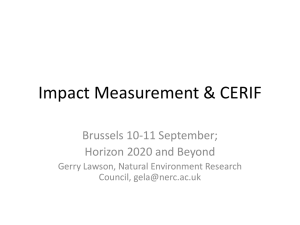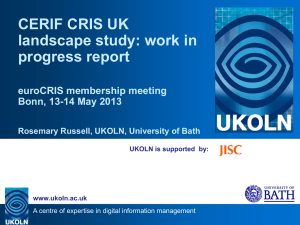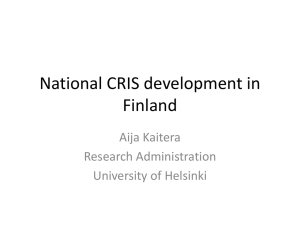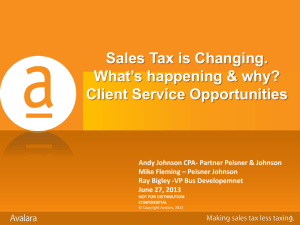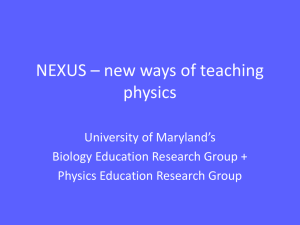RMAS - Murg
advertisement
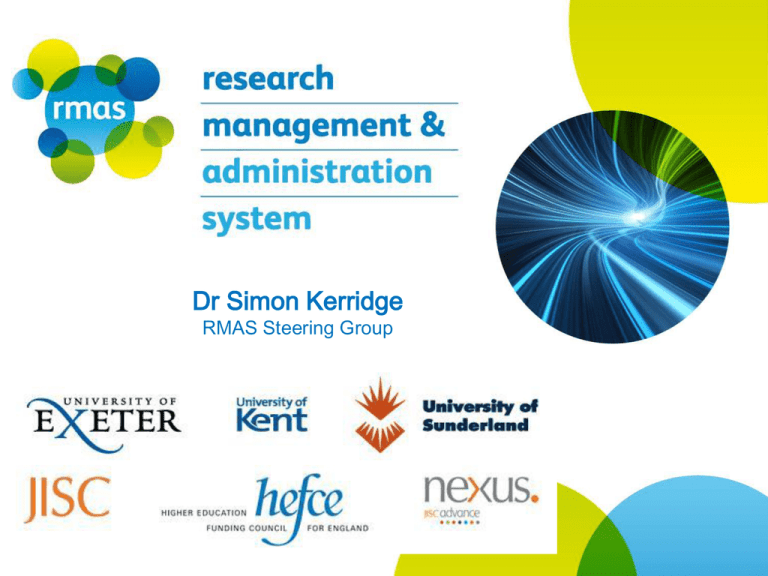
Dr Simon Kerridge RMAS Steering Group Funding Context • Financial pressures on HEIs • Efficiency Agenda • Vfm in Research • Shared Services RMAS Feasibility Study 2009 Cashable Benefits • Staff efficiencies: 10-20% Non-cashable Benefits • Free research active staff • Enable growth • Better management Info • Data exchange efficiencies RMAS Benefits Analysis 2012 Productivity gains • £75k per RMAS module Qualitative Benefits • Enable growth • Improved data quality • Flexible platform for future developments Universities Modernisation Fund HEFCE approach: • Could have left to the market • Focusing public funds to: • share risk • accelerate timescales and • tailor to HEIs’ needs • helping address the cultural issues Universities Modernisation Fund • • • • • £½m benchmarking £1m shared services £6m procurement £2½m Admin applications £10m data centres and research applications UMF Delivery RMAS: • RMAS product suite • Data integration and standards • Pilot HEI efficiencies • Cloud based delivery model UMF Programme: • £14.9m efficiencies – Year 1 HEFCE vision What is RMAS? • RMAS is NOT a single, off-the-shelf system But it is: • A procurement framework containing the ‘best-of-breed’ research systems on the market, • plus a set of free integration tools and methodologies, • being built around a data standard for research information, CERIF How does that help you? How does RMAS help you? How does that help you? Then, when adding or upgrading… What has the RMAS Project Done? • created a procurement framework containing products that meet your needs – select & buy! • developed a set of free tools and ‘how-to guides’ so you can integrate your systems and data – no need to reinvent the wheel! • Enhanced CERIF to include more data sets, created CERIF conversion tools & convinced suppliers to develop their systems to communicate via CERIF. RMAS Procurement RMAS Launch Event, July 10th, 2012 Why Create the RMAS Procurement Framework • • • • • • • RMAS Feasibility Studies 2008/9 Clear demand Similar customer requirements Improve the procurement process for the sector Create a collaborative environment Issues of coverage and integration Lack of clarity on standards Benefits of the Framework • The average OJEU timetable of 6-9 months can be reduced to 4 weeks or less • There are no full tenders to assess - suppliers can be appointed through mini-competitions • Pre-agreed Terms and Conditions provide solid contractual safeguards and reduced professional legal costs, while allowing amendments to suit particular projects What it Means in £££££ Further Benefits of the Framework • You can access the Framework for free • Long-term relationships between clients and suppliers through a framework encourage improvements in service • Having several suppliers allows flexibility to cater for a range of requirements, and maintains competition • Frameworks help to maintain security of supply • Capture of knowledge and best practice Who Can Use the Framework • Educational Establishments in England and Wales including Schools, Universities and Colleges • Scottish Further and Higher Education Bodies • Further and Higher Education in Northern Ireland • Central Government Departments, Executive Agencies and NDPBs • Welsh Public Bodies National Assembly for Wales, Welsh Assembly Government and Welsh Local Authorities How to Use the Framework RMAS Framework Lots RMAS Framework Suppliers Deployment Options • On campus • Cloud based • Integration options • Supplier web services where they exist • Create your own adapter • Use the Nexus ESB Management of the Framework • Moving toward CERIF compliance • Integration using recognised standards and processes • Improvements for customers RMAS Integration RMAS Launch Event, July 10th, 2012 http://source.rkt.clients.switchsystems.co.uk/intro.php RMAS Launch Event, July 10th, 2012 The Role of CERIF in RMAS RMAS Launch Event, July 10th, 2012 What is CERIF? • • • • Common European Research Information Format An EC-Recommendation to Member States Development since late 1980s The responsibility of euroCRIS since 2002 CERIF The CERIF Evolution CERIF 1.5 (XML) CERIF 1.5 CERIF 1.3 Infrastructure Link Base Similar Ideas UN/UNESCO OECD CODATA CERIF 2006 / 2008 Model Base Link 2ndLevel Semantics Measurement Language GEO Semantics Language 2ndLevel Funding Equipment Facility ExpertiseAndSkills ResultPublication EU Working Group on Research Databases Workshop CERIF 2000 Model Prize ResultPatent ResultProduct ElectronicAddresse Project Funding Programme Person Roles EXPERTISE Skills Project OrgUnit CERIF 91 PERSON - EC Recommendation to Member States 1991 OrganisationUnit Person Citation Service Metrics Indicator Equipment Measurement Country Patent Product Event Language Classification (Semantics ) Currency Event EQUIPMENT PROJECT - Networking of DBs - Exchange of Records PostalAddress Organisation PROJECT RESULTS Acronym: ERGO Participant: Keith Jeffery, Anne Asser son, many more Organisations: Rutherford Appleton, University of Bergen, … CV Publication CV 1987 Service Qualification CLASSIFICATION - Data Model - Multilinguality - Controlled Vocabulary - Roles / Types - User-driven - EC Recommendation to Member States 2000 - Data Model - Infrastructure - Facility, Equipment, Service - Measurement & Indicator - Entities and Link Tables - Geographic Bounding Box - Data Model - CERIF 1.3 Vocabulary - Model Normalization - UUIDs - Robust/Consistent Structure - Terms - Extensible Structure + Linked - Schemes - Semantic Layer Data - XML Exchange Specification - Elaboration on Publication + CERIF - CERIF Core Semantics (2008 1.2) Ontology 2006 2008 2012 F O R M A L S E M A N T I C S Common European Research Information Format • • • • A formal Model of the Research Domain Research Entities Relationships (Contexts) • Enables Contextual Vocabularies (i.e. Semantics) CERIF Common European Research Information Format Research Context: Finance, Funding, Output, HR, Project-MM, Infrast... CERIF Common European Research Information Format Research Contexts: Finance, Funding, Output, HR, Project-MM, Infrast .. CERIF A particular use-case (context) OrgUnit M member Part of employee Person A OrgUnit O member OrgUnit N Project leader Project P Part of author owns IPR Publication X CERIF The RMAS use-cases (areas) • • • • • Human Resources Projects OrgUnit A Outputs Finance employer Students Funding X agreement performance Measure Y member Project P owns IPR result Person P author budget income / expenditure peerreviewed Output X CERIF CERIF for N use-cases • Formal Syntax • Declared Semantics Funding D C OrgUnit B Measure A X Z G Person i.e. open to any vocabulary ... A, B, C, D, E, ... X, Y, Z Project Y E F Output CERIF Benefits of employing CERIF Learning Funding Finance Output HR Project Infrastructure Standardisation allows for re-use; saves time, thus costs CERIF Benefits of employing CERIF • • • • a tangible formal model for re-use, communication, comparison to support interoperability, exchange to support area identification, process modeling, vocabulary development • it scales; is open for any vocabularies Standardisation allows for re-use; saves time, thus costs CERIF Benefits of employing CERIF with RMAS In areas: HR, Project, Output, Finance, Students (by analysis of existing systems) (comparable to supplier products) • • • • entity identification and disambiguation entity relationship identification vocabulary identification (quality) vocabulary definition CERIF Results from euroCRIS/RMAS collaboration CERIF-driven RMAS Vocabularies Also imported in part vocabularies from CASRAI, CIA project, CERIF itself, HESA • Persons: Title, Qualification, Contact Type, Event Involvement, Employment Type, Professional Relationship, Output Contribution, Degree Level of Study, Person Project Role • Projects: Activity Type; Subtype, Organisation Project Role, Activity Funding Type, Activity Status, Activity Finance Category, Activity Finance Category Amount • Outputs: Output Type, Publication Status, Peer-Review, Output Quality Level, Output Output Relationship, Open Science Cost • Finance: Funder Type, Funding Source Type • Students: -> Person-Person Role, -> Output Type • Overall: Verification Status CERIF Results from euroCRIS / RMAS collaboration CERIF-driven RMAS Vocabularies • • • • Will be formalized in latest CERIF XML A starting point for suppliers Have been published on www.euroCRIS.org Will be supported by RMAS SAC* •SAC = Supplier Agnostic Connector CERIF RMAS Pathfinders • University of Kent • Simon Kerridge • University of Sunderland • Kevin Ginty • University of Exeter • Steve Trowell Or contact JISC Advance - Simon Foster University of Kent • Research Led • ~£12M, ~600 proposals University of Kent Je-S, eGAP, EPSS.. REF DCS ROS External Data sources (UKRISS) Funding Sourcing Academic Expertise Reporting Costing & Financial Proposal Management Outputs & Outcomes Post Award HR SIS/PGR Financial Planning Finance University of Kent Je-S, eGAP, EPSS.. REF DCS Research Professional Funding Sourcing pFACT Costing & Financial EPrints ROS External Data sources (UKRISS) Academic Expertise Reporting Proposal Management Microsoft Reporting Services Outputs & Outcomes Post Award HR SIS/PGR Financial Planning Finance PSE In-house Cognos Agresso University of Kent Je-S, eGAP, EPSS.. REF DCS ROS External Data sources (UKRISS) Funding Sourcing Academic Expertise Reporting Costing & Financial Outputs & Outcomes Proposal Management Communication Bus HR SIS/PGR Financial Planning Post Award Finance University of Kent Challenge: Connect everyone to everyone • Different suppliers • Different technologies • Different data schemas RMAS CERIF Proposal-created Proposal-updated Proposal-removed Proposal-submitted Proposal-approved Proposal-rejected Start small Release often Build a community University of Sunderland • Research Active • ~£2M, ~100 proposals CRM Workflow Electronic Document Management Academic Expertise Funding Sourcing Tool Central Enterprise Service Bus Proposal Management Costing & Financial Management Proposal Management Post Award Management Local ESB Costing & Financial Management Outputs & Outcomes RMAS – Sunderland evolution Preaward Costing & Pricing ESB RMAS – Sunderland evolution pFACT (Converis)* ESB ColdFusion * Alternatively CRM (UNIS) Top Level Components UNIS pFACT CF Converis Sunderland – systems integration • • • • Chris21 (HR) Oracle Projects (Finance) SITS (Student records) EPrints (Institutional repository) [SURE] Sunderland – Comms Bus Further Information • RMAS Recipe Book • RMAS Roadmap • www.rmas.ac.uk • Exeter Overview • Research intensive ~800 Academics; ~3000 projects • Ambitious growth in research income • ~ £50m in 2011-12, doubled every 4 years Exeter Research Systems Pre-Award RMAS Funding Opportunities Funding Opportunities Proposal Management Proposal Management Post Award Management Finance (APTOS) PGR (SITS) Post Award Management Publication Management Publication Storage Publication Storage Research Data Storage Research Data Storage Outputs Monitoring Outputs Monitoring Research Output Core Corporate System Projects & CRM Projects & CRM Publication Management Research Output Developed During RMAS Post-Award Existing System HR (Trent) Post-Award HR (Trent) Key Planned for Future Project Costing Project Costing Following RMAS Pre-Award Prior to Finance (APTOS) PGR (SITS) RMAS Developments • • • • In-house Systems Development: iPAC and ROMe • Rapid system development e.g. iPAC 16 weeks from conception to deployment • ROMe demonstrates mapping from non-CERIF source into CERIF within integration • Total benefits around £150k per annum in operational productivity gains Systems Integration • SQL – methods based on freely available tools, industrial standards • Supplier Agnostic Connector – open source tool, freely available from RMAS website, designed to facilitate connecting existing systems Data Standards • With other Pathfinders, mapped data fields used in research systems to CERIF • With EuroCRIS, developed new vocabularies for HR, Finance, Project, Student and Publications entities Framework for Analysis of Benefits - led to a benefits-driven approach iPAC – Project Overview iPAC – Spend Against Budget Profiles iPAC – Data Quality Grid ROMe – Outputs & Outcomes Lessons Learned • Improvements in Data Quality in Source Systems • RMAS integration techniques reliably combine data from disparate sources enabling verification by those who know the data best • Avoidance of ‘hidden costs’ of poor data quality [duplication, discrepancy analysis] • RMAS integration facilitates conversion of data into information, adding value through graphical displays and customer-centric user interfaces • Positive experience of users and increased confidence in data quality makes user engagement easier to secure aiding future developments • Agreed data standards [CERIF] are essential for external communications • Expertise in use of CERIF internally, connecting to non-CERIF source systems Summary • RMAS has been integral to delivery of major advances in our research systems infrastructure during last 12 months • Gaps remain – plan to use RMAS procurement framework in coming weeks to procure a pre-award solution • Development of expertise in system integration and rapid system specification, design and implementation • Benefits-driven approach rippling through entire research system development programme • Dissemination of learning into other projects e.g. UKRISS and DESCRIBE RMAS Supplier Agnostic Connector What is the RMAS Supplier Agnostic Connector ? • A tool to integrate data from research management and administration systems • It uses an Extract Transform & Load (ETL) Pattern • Compatible with CERIF • Built on a mature open source platform • Custom built for RMAS • Includes working examples – – – – HR to supplier specific CSV Publications to CERIF XML Publications to CERIF XML for project costings Key mapping using an ESB with CERIF XML How Do I Use It ? RMAS Website 1. Access the connector at www.rmas.ac.uk 2. Download and install the working demonstrators 3. Use the documentation to move from demo to real data sources and targets What is Extract, Transform and Load • An ETL is a three stage system for moving data Targets Sources Extract Transform Load HR HR Publications Publications Finance Finance Projects Projects CERIF XML CERIF Compatibility • Extract Stages – Reads data sources and converts to CERIF compatible data model • Transform Stages – Works with a collection of data fields defined within the CERIF vocabulary • Load Stages – Includes a CDM to CERIF XML export stage Summary • A tool kit to enable data integration • Working examples to speed development • Freely available, open source, community based • CERIF compatible • Available from www.rmas.ac.uk The future of RMAS RMAS Launch Event, July 10th, 2012 RMAS Coordinator Role (Simon Foster) •Single point of contact •Provide support and signposting for RMAS adopters •Maintain & develop relationships with key stakeholders •Manage transition to Nexus simon.foster@jiscadvance.ac.uk Sustainability phase work areas •Support for RMAS Adopters •Continuation of RMAS/CERIF development •Moving suppliers toward CERIF/RMAS compliance •Working with suppliers in areas that benefit the sector Sustainability phase work areas •Support for RMAS Adopters -RMAS Repository -Web Resource -Technical Support from RMAS Pathfinders -RMAS Community -Support in utilising CERIF RMAS Repository RMAS Tools RMAS Web Resource www.rmas.ac.uk Managing Relationships & Strands UK Universities RMAS Coordinator CERIF Support National Coordinator / RMAS Framework Suppliers Transition to Nexus • New Commercial Service from JISC Advance • Open Source Enterprise Service Bus Technology • Ongoing Management of RMAS RMAS & JISC Advance Nexus What is Nexus • Nexus is a new commercial service by not-for-profit service organisation JISC Advance • Nexus enables seamless data transfer within institutions and to remote services and external agencies. • Connected approach uses Enterprise Service Bus (ESB) technology to provide secure information exchange between software applications. • Nexus delivers the crucial connections between academic administration systems, teaching and learning environments, remote services and external agencies. The role of Nexus in the sector •Joining up services •Cost effective integration options for the sector JISC Advance Nexus’s role in RMAS • Management of the framework • Provision of liaison support for early adopters • Interpretation of the contract • Dissemination of information Where RMAS fits in with Nexus •Enterprise Service Bus technology • Deployed centrally or as a Local ESB •Cloud-based systems routed through the Nexus ESB •Remote and Shared services Where RMAS fits in with Nexus Where RMAS fits in with Nexus The Nexus Vision Where will Nexus take RMAS •Towards and evolving standard •Integration of new & existing systems •Working collaboratively with suppliers SLC HEFCE HESA L A’s UCAS HEDD TfL DARE UK BA SR VLE Nexus NHS RMAS Modules Data Standards & Adapters Data Standard Bodies Suppliers Services and University Products University ESB Community Universities University University University University ESB or Adapter RMAS HR VLE ID SR University ✔ ✔ ✔ ✔ ✔ ✔ ✔ ✔ ✔ ✔ ✔ ✔ ✔ ✔ ✔ Benefits • ESBs have been used to – Make processes better faster cheaper – Improve the student experience – Automate information provision – Free up administrator time – Reduce/eliminate provisioning delays – Improve cash flows – Reduce the cost of IT – Improve data quality What does it cost? • Not-for-profit • Annual subscription of – £5k for the first endpoint pair – £1K for subsequent endpoint pairs • Plus very competitive implementation costs – However if an institution asks them to solve a problem for which there is substantial demand, Nexus may choose to waive to cost of implementation for the first customer. Want to know more? • Join the linked in group – JISC Advance Nexus • Email – sharlene.jobson@jiscadvance.ac.uk – clare.mckenzie@jiscadvance.ac.uk • Phone – 0203 006 6054 Are there any questions? Simon Kerridge or contact Simon Foster simon.foster@jiscadvance.ac.uk
